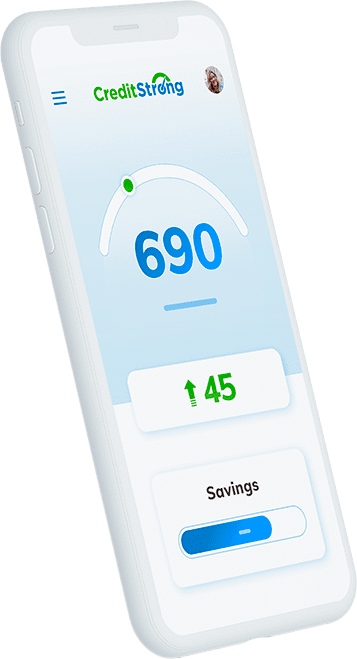How Does Credit Strong Compare to Other Credit Building Accounts?

Build strong credit
while you save
Establishing, building, or rebuilding credit can require a two-pronged approach. The first is to manage your current accounts by making on-time payments and paying down credit card balances. The second is to open new credit accounts that can help expand your credit file and allow you to add new positive information to your credit reports.
Financial institutions offer two types of accounts to help people build or rebuild credit — credit builder loans and secured credit cards. Each has its benefits and drawbacks, and you could choose one or both types of accounts as you work to improve your credit.
However, before jumping into the details about these products, it could be helpful to review what impacts your credit scores.
The Primary Credit Scoring Factors
Credit scoring is a complex and competitive industry and the main competitors in the US are FICO and VantageScore. Both companies create credit scoring models that examine the information in one of your credit reports to determine a credit score.
These generic credit scores (meaning they’re created and offered to multiple types of lenders) generally have the same goal — to determine the likelihood that a borrower will fall 90-plus days behind on a debt during the next 24 months. Lenders can choose which model to use, or even create their own custom models. There is an exception, though. If you apply for a conventional mortgage loan, most mortgage lenders will use specific FICO scoring models.
Most of the FICO and VantageScore scoring models have a range of 300 to 850, with a higher credit score indicating a person is less likely to miss a payment. Each scoring model might consider or weight information differently, and the impact of new information in a credit report can depend on a person’s overall credit profile.
However, because there’s a precise goal and the scoring models use the same data from your credit report, many generic scoring models have similar scoring factors:
- Payment history: Primarily, whether you’ve paid bills on time or been late with payments. Late payments can hurt your scores, and the later the payment, the greater the negative impact. Defaulting on an account, having an account sent to collections, or declaring bankruptcy can also hurt your scores.
- Current credit usage: How much of your available credit limits you’re currently using, which is also known as your utilization rate. Keeping your credit card balances low can help your scores, while high balances can hurt them. For some credit scores, the balances on lines of credit can impact your utilization rate.
- Length of credit history: The average age of the accounts in your credit history (including closed accounts), the age of your newest account, and the age of your oldest account can all impact your credit. Older is often better in this case.
- Mix of credit accounts: Having experience handling different types of credit accounts could be good for your scores.
- Recent applications: If you’ve recently applied for new credit accounts and the lender reviewing your credit with a hard inquiry, that could lead to a drop in your scores.
Learning about what credit scoring models look for in your credit report can make it easier to understand why your credit scores might increase or decrease, and can help you make strategic decisions to improve your credit.
| Factor and Weight | What it Means | How CreditStrong Helps Your Credit Profile |
|---|---|---|
| 35% Payment History |
Payment History The record of every on-time, late, or missed payment for extensions of credits you have received. |
By making your monthly payments on time, CreditStrong helps you demonstrate a responsible pattern of on-time repayment that lenders look for when making credit decisions. Making on-time payments positively impacts your credit profile while missed or late payments negatively impact your credit profile. |
| 30% Amounts Owed |
Amounts Owed How much you owe each creditor individually and in total. It includes your utilization rate for revolving lines of credit (e.g. credit cards). |
When you initially open your CreditStrong account your amounts owed will increase which may cause a temporary small dip in your credit score. As you make regular on-time monthly payments your amounts owed will decrease and it will positively impact your credit profile. |
| 15% Length of Credit History |
Length of Credit History The length and age of each trade line on your credit report individually and in total. |
The longer the term of your CreditStrong account (e.g. 24 months vs. 12 months) the greater the potential positive impact on your credit profile. |
| 10% Credit Mix |
Credit Mix The types of credit used; Revolving: Credit cards or revolving lines of credit and/or Installment: Fixed loan amount and payment. |
Your CreditStrong account includes an installment loan. It is important to have both installment loans and revolving lines of credit on your credit report to maintain a well-rounded credit profile. |
| 10% New Credit |
New Credit New account opening activity and any recent ‘hard’ credit inquiries from lenders on your credit report. |
CreditStrong does not perform a ‘hard’ credit inquiry. Your account will show up on your credit report as a new installment loan. The potential small initial negative impact of adding a new loan to your credit profile will be far outweighed by the positive impact of demonstrating a pattern of on-time repayment. |
How Can a Credit Strong Loan Impact Your Credit?
A credit builder loan from Credit Strong, a division of Austin Capital Bank, can impact each of these factors in different ways:
- Payment history: By opening a new account, you have the opportunity to make on-time payments and build a positive credit history.
- Current credit usage: As an installment loan, a Credit Strong loan won’t negatively impact your utilization rate. The amount of money you owe relative to the total loan balance could be a credit scoring factor, but it’s generally not a major scoring factor.
- Length of credit history: Opening a new credit account can lower your average age of accounts, which may hurt your scores at first. But over time, the account will age and could help your scores. Even after you complete the repayment process, the account can remain on your credit reports for up to 10 years and continue to add to the average age of accounts.
- Mix of credit accounts: A Credit Strong loan is an installment loan, which could add to your credit mix if you’ve only used revolving accounts, such as credit cards and lines of credit.
- Recent applications: Applying for a Credit Strong loan doesn’t lead to a hard inquiry and there’s no negative impact on your credit.
Credit Strong vs Other Credit Builder Loans
By taking out a credit builder loan and making on-time monthly payments, you can build your credit while amassing savings that you’ll have access to at the end of the loan’s term. Along with Credit Strong, online lenders, banks, and credit unions all offer credit builder loans.
No matter which lender you choose, the loan could have a similar impact on your credit. However, you want to compare the fees and features of each lender before applying.
Credit Strong may stand apart from other lenders because:
- You don’t need an upfront security deposit to open a Credit Strong account.
- Applying with Credit Strong won’t lead to a hard inquiry, which could lower credit scores.
- Credit Strong reports your payments to all three major credit bureaus, Equifax, Experian, and TransUnion.
- You can complete the application process online and don’t need to become a member of a new bank or credit union.
- Your loan is placed in an FDIC-insured savings account and accrues interest, which you’ll receive at the end of the loan term.
- There’s a 14-day, fee-free grace period for late payments.
- If you don’t think you’ll be able to afford a monthly payment, you can close your account without paying a prepayment or early termination fee. Credit Strong won’t report a late payment to the bureaus if you close the account before a monthly payment is 30 days past due.
- You can choose from eight different loan options, with monthly payments ranging from $15 to $150 a month.
- There is only an $8.95 administrative fee to set up your account, while some other lenders charge administrative or origination fees of $10 to $75.
You can learn more about Credit Strong and find answers to common questions in the FAQ.
Credit Strong vs Other Methods for Building Credit
In addition to credit builder loans, there are two popular methods for establishing, building, or rebuilding credit: secured credit cards and becoming an authorized user on someone else’s credit card.
Secured Credit Cards
To open a secured card, you’ll need to send the card issuer a refundable security deposit. You may be able to choose the deposit amount, which will often determine your card’s credit limit. As you use the card, the card issuer reports your payments to the credit bureaus.
Secured cards can add to your credit mix and allow you to build positive credit history by making on-time payments. If you never have a high balance, perhaps by only using your card for one small purchase each month and then paying the bill in full, the low utilization rate can also help your credit.
The downside is that you’ll need to send the issuer the security deposit (Credit Strong doesn’t have any up-front cost aside from the administrative fee). Secured credit cards can also have annual fees, and some card issuers don’t report your payments to all three major credit bureaus.
Also, for people who tend to overspend on credit cards, having a secured card could lead to maxing out the card and carrying a balance. In addition to paying interest, the high utilization rate could hurt your credit.
Becoming an Authorized User
When someone adds you as an authorized user on their credit card, the card issuer may start reporting the card’s activity to the credit bureaus under your name. In some cases, the entire card’s history could wind up on your credit reports, which could quickly increase your average age of accounts.
There’s no cost associated with becoming an authorized user, and it can be a good option for improving your credit. However, you’ll need to find someone who you can trust and who has good credit habits. You’ll also have to be okay with the other person being somewhat in control of your credit.
Even if you receive a card as an authorized user, the primary cardholder remains responsible for the entire monthly payment. If the person misses a payment, the late payment could also show up on your credit report. Similarly, if the account balance rises, the high utilization rate could hurt your scores.
What’s Best for Building Credit?
Adding new, positive information to your credit reports can be important if you want to improve your credit. You can do this by managing your current accounts and opening new accounts that will report your payments to the bureaus.
While the types of information can vary depending on whether you take out a loan or open a credit card, the credit scoring models don’t consider which lender or card issuer you use. However, that doesn’t mean they’re all equal. Even if it won’t directly impact your scores, you may want to carefully compare your options because the fees, rates, and benefits can all vary from one financial institution to another.
CreditStrong helps improve your credit and can positively impact the factors that determine 90% of your FICO score.
